Acne
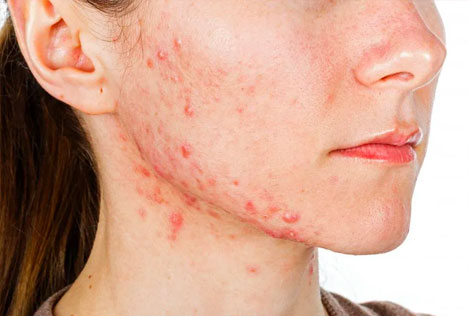
Acne is the most common skin disease in the world — 80 percent of all people experience an acne breakout at some point in their lives, often during the teenage years. About 40–50 million Americans have acne at any given time. This is a skin condition that occurs when your hair follicles become plugged with oil and dead skin cells. It causes whiteheads, pimples, or blackheads. Propionibacterium acnes bacteria found on the skin can become trapped in clogged pores. As the bacteria thrive on the sebum, and pustule begins to form. Over time this triggers an inflammatory response from and a deep, tender cystic lesion may form, which may eventually lead to follicle rupture if untreated.
Acne vulgaris most frequently affects the face, neck, back, chest, and shoulders, areas that tend to have the greatest concentration of oil-producing glands.
Types of Acne
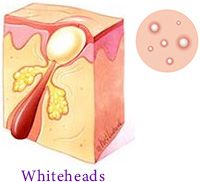 There are non-inflammatory and inflammatory acne types. Non-inflammatory acne includes whiteheads and blackheads. They are the least severe forms of acne and are easier to treat than inflammatory acne types. Inflammatory acne is more severe than non-inflammatory acne and may cause complications such as scarring. This acne type includes papules, pustules, nodules, and cysts.
There are non-inflammatory and inflammatory acne types. Non-inflammatory acne includes whiteheads and blackheads. They are the least severe forms of acne and are easier to treat than inflammatory acne types. Inflammatory acne is more severe than non-inflammatory acne and may cause complications such as scarring. This acne type includes papules, pustules, nodules, and cysts.
Self-medication can be harmful to your skin, and only a top-rated NYC acne dermatologist knows how to get rid of acne and select the proper treatment for a particular acne type.
Whiteheads
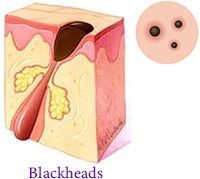 Whiteheads are small and whitish spots or bumps. They usually have a white, circular center surrounded by a red halo. The skin around a whitehead may become tight or wrinkled, especially if the whitehead is large. This type of acne doesn’t cause acne scarring.
Whiteheads are small and whitish spots or bumps. They usually have a white, circular center surrounded by a red halo. The skin around a whitehead may become tight or wrinkled, especially if the whitehead is large. This type of acne doesn’t cause acne scarring.
Blackheads
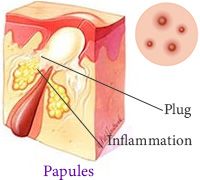 Blackheads are small, black, or dark spots. They are not a result of trapped dirt. Blackheads are simply whiteheads that are exposed to air. When the oil makes contact with the air, the blockage turns dark.
Blackheads are small, black, or dark spots. They are not a result of trapped dirt. Blackheads are simply whiteheads that are exposed to air. When the oil makes contact with the air, the blockage turns dark.
Papules
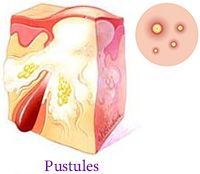 Papules are bumps under the skin’s surface and have no visible center. They develop when whiteheads cause irritation and damage some of the surrounding skin, which leads to inflammation.
Papules are bumps under the skin’s surface and have no visible center. They develop when whiteheads cause irritation and damage some of the surrounding skin, which leads to inflammation.
Pustules
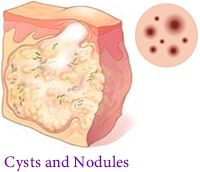 Pustules are large bumps with a defined circular center that is filled with pus. They typically look like large and more inflamed whiteheads that have visible red inflammation in the surrounding skin.
Pustules are large bumps with a defined circular center that is filled with pus. They typically look like large and more inflamed whiteheads that have visible red inflammation in the surrounding skin.
Cysts and Nodules
 Cysts and nodules are the growth of abnormal tissue and develop below the skin. They can also develop in deeper skin tissues or internal organs. These acne lesions are large and painful and often leave scars.
Cysts and nodules are the growth of abnormal tissue and develop below the skin. They can also develop in deeper skin tissues or internal organs. These acne lesions are large and painful and often leave scars.
Levels of Acne Severity
There are three levels of acne severity on standards of the American Academy of Dermatology system of the grading of acne:
- Mild acne is the most common. It includes blackheads and whiteheads. If you only have a few clogged pores or they’re in an isolated spot, your acne is “mild.”
- Moderate acne means you have more pimples than blackheads or whiteheads. With this type of acne, you may notice that some of your pimples have red skin or inflammation around them.
- Moderately severe acne includes numerous papules and pustules and occasional inflamed nodules. They may also occur on the chest and back.
- Severe acne is when you have nothing but pimples, both those that are small bumps and those that are yellowish and filled with pus. Additionally, severe acne can include nodules or cysts.
Nearly 50 million Americans suffer from acne, 16 million from rosacea, 8 million from eczema, and 7.5 million from psoriasis.
Acne Treatment
The general rule of thumb is that the earlier you start treatment, the less likely you are to have scars. There are many over-the-counter treatments, but if you’ve used them for several weeks or more with no improvement, it’s time to see an acne doctor in NYC. A dermatologist in Manhattan works to treat the acne you have, prevent further breakouts to avoid further scarring, and provide treatment to make your scars less noticeable.
You have several options available to you when it comes to treatment. Your Manhattan acne dermatologist can review each in detail. Depending on the severity of your acne, she’ll guide you through treatment options that are best for you. There are three general options for treating acne:
Topical medications
Topical medications are the standard of care for mild and moderate acne and can prevent new lesions. They require at least six to eight weeks before any improvement is seen. Topical treatments include retinoids, antimicrobials, sulfur, or dapsone.
- Retinoid therapy acts on follicular keratinocytes to prevent excessive cornifications and follicular blockage. This therapy decreases the number of comedones and inflammatory lesions by 40-70%. The most commonly available topical retinoids are tretinoin, adapalene, and tazarotene. The most common side effect is irritation with erythema and scaling. Optimal response occurs after 12 weeks.
- Antimicrobials are effective in treating inflammatory skin conditions. They include benzoyl peroxide and antibiotics and have moderate comedolytic and anti-inflammatory properties. This treatment can be fast-acting, with a response as early as five days.
- Sulfur is a natural component that helps reduce skin oiliness and prevents pore blockage. Sulfur also has antimicrobial properties and helps keep the acne-causing Propionibacterium acne in check.
- Dapsone is a medication that possesses both antibacterial and anti-inflammatory properties. It’s successfully employed in the management of moderate to severe acne.
Oral medications
An acne dermatologist will use oral medications, especially when your acne isn’t responding to topical medications. These include antibiotics to control inflammation and bacteria growth, combined oral contraceptives, an anti-androgen agent, or the drug isotretinoin (Accutane). Your doctor can explain what each does and what the risks are.
Other therapies
Other therapies include red and blue light therapy, chemical peels, whitehead and blackhead extractions (acne facial or medical cleanse), corticosteroid injections (cortisone shots).
- Red light therapy and blue light therapy are used to treat mild to moderate acne. Blue light therapy and red light therapy are both types of phototherapy. This treatment is safe for anyone and has mild side effects.
- Chemical peels are used for the treatment of acne vulgaris and other skin disorders. They have antibacterial, anti-inflammatory, keratolytic, and comedolytic effects and are also able to reduce sebum production.
- Whitehead and blackhead extractions are a part of facial acne treatment. First, a Manhattan acne specialist prepares the skin by lightly steaming the area. Your acne doctor may also exfoliate the skin before extractions begin. This helps prepare the comedones and the pore for easier extracting. Next, the doctor does whitehead and blackhead extractions. This procedure, if done regularly, will help reduce acne breakouts.

50% of adult women have acne. This percent increases during pregnancy. 25% of adult men suffer from acne.
The Effects of Hormones on Acne
Hormones often play a role in acne and may trigger it, especially in adolescence, when hormones increase in both boys and girls. Infants can get acne as a result of hormones transferred from the mother after birth or through breastfeeding. Some women find that hormonal shifts throughout their lifetime (i.e., pregnancy, menopause) can cause acne even if they didn’t have it as a teenager.
The Effects of Stress on Acne
Stress impacts your body in many ways, mainly by leading to fluctuations in hormone levels. That is why many people often find that their acne flares up when their stress level is high.
The Effects of Medications on Acne
Certain medications and herbal supplements can cause acne as a side effect. Make sure you tell your dermatologist about all the medications and supplements that you’re currently taking in order to determine if they may be contributing to your acne. You will probably need a change in medication.
The Effects of Diet on Acne
A high glycemic index diet has shown some correlation with acne exacerbation, as have dairy products in patients who have hormonal acne. A common myth is that chocolate is thought to make acne worse, although there are no studies to support this theory. Scientists haven’t found a link between certain foods and acne breakouts. However, if you notice a particular food triggers your acne, try to avoid or limit it.
The Effects of Hygiene on Acne
Having acne doesn’t mean that your skin is dirty or that you’re not washing it enough. On the contrary, acne-prone skin is sensitive, and using harsh skin cleansers or scrubbing can irritate your skin and make your acne worse. Gently washing with a mild cleanser once or twice a day is recommended to remove excess oil and impurities from the skin.
The Effects of Cosmetics on Acne
Cosmetics, especially if oil-based, may further contribute to clogged pores. It is crucial to use products that are labeled “noncomedogenic,” which means they are less likely to clog the pores. Mineral makeup is better than liquid makeup. Sleeping in makeup can cause acne breakout, and therefore, you need to remove it every night before bed.

96% of people with acne believe there is a cure, and 4% know that acne can’t be cured but can be treated effectively. Americans spend well over 1.4 billion dollars a year on acne products. Yet, 40% of acne sufferers do nothing to treat acne.
Important Reminder: This information is only intended to provide guidance, not definitive medical advice. Please consult dermatologist NYC about your specific condition. Only a trained, experienced board-certified acne doctor can determine an accurate diagnosis and proper treatment.
Frequently Asked Questions
What Are the Home Remedies for Acne?
There are certain types of products that can lessen the symptoms of your skin disease.
Acne treatment at home involves:
- Honey and Cinnamon face masks
- Green Tea
- Aloe Vera gel
These products have antioxidant and antibacterial properties that can soothe the skin. You may also use Zinc supplements and facial scrubs for more effective treatment.
Be aware that home treatment with inappropriate ingredients may lead to various complications. Consult with your doctor before applying any skin treatment techniques.
What Are the Common Foods That Cause Acne?
Common causes of adult acne are often associated with a poor diet. Pay attention to whether you consume these types of products:
- Fast Food
- Sweets
- Dairy Products
- Foods Rich In Omega-6 Fats
- White flour products
Don’t rush to exclude dairy and white flour products from your diet. They’re rich in proteins and vitamins essential for your health. Ask your doctor about a personalized nutrition plan and the types of products you should avoid or include in the diet.
How Long Does Acne Last?
Teenage acne usually starts at age 12 and can last from 5 to 10 years. Normally, the skin clears out during the early 20s, when the hormone levels stabilize. Skin disease in adults can last until the causes of the disorder are resolved. Adult acne treatment may involve prolonged therapy and changes to lifestyle. Make an appointment with an acne specialist in NYC to discuss the fastest and most effective treatment of your skin disorder.
Do you have any questions about Acne? Would you like to schedule an appointment with an internationally recognized, top dermatologist in NYC, Dr. Susan Bard of Manhattan Dermatology Specialists? Please contact our Midtown or Upper East Side NYC office for a consultation with Manhattan dermatologist Dr. Bard.
(212) 427-8750 Manhattan Dermatology (Midtown) 56 W 45th St, Ste 819, NY 10036
(212) 889-2402 Manhattan Dermatology (Union Square) 55 W 17th St, Ste 103, NY 10011
(212) 378-9984

